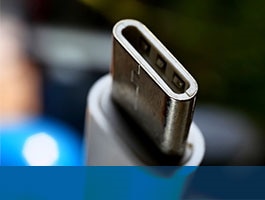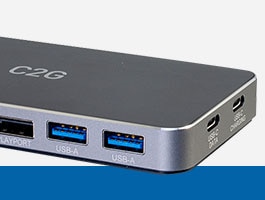USB Type-C as a Power Source
Without drilling down to granular details, our legacy USB system can deliver about 4.5 watts of power (5 volts at 900mA) when the link is transporting data, or 15 watts (5 volts at 3 amps, USB BC 1.2) for dedicated charging without data transfer. This amount of power works well for running smaller USB devices like flash drives, a keyboard or mouse. It can also charge smaller USB devices like smartphones, tablets and wireless headphones. When a device is first connected to the USB network, it’s given a USB network address (enumerated) and a certain minimal amount of power. The device then negotiates with the USB host for additional power, up to the maximum.
USB Type-C Power Delivery. via a Dual-Role-Power/Data (DRP/DRD) port, changes that completely. For the sake of legacy compatibility, USB Type-C enabled power sources will default to the traditional USB standard for devices and connections that don’t “advertise” themselves as being capable of more. This is a revolutionary concept, not because a device needs to communicate its needs, but because the cable must also play a part!
USB Type-C uses the configuration channel (CC1 & CC2, pins A5 & B5 on the USB Type-C connector) for power negotiation. The system can support up to 100 watts (20 volts at 5 amps). Power transfer is transparent to any data transmission mode, and can therefore be used with any of them without any loss of wattage due to simultaneous data transportation. USB Power Delivery specification (USB PD 2.0), defines the voltage levels a USB Type-C power source may deliver and allows the supply to support any output power from 0.5 W to 100 W so long as it’s within the ability of the source and the cable. This increased power delivery is enough for larger devices like laptops and monitors. Included in the specification is a cable ID function wherein the connecting cable must define its maximum performance parameters independently of the host and client. Despite its name, PD is not limited to just power negotiations Alternate Mode, and Data Role switching (swapping of upstream and downstream facing ports and roles) is achieved through PD.

Graph of USB Power Delivery Protocol voltages and power
Familiarity with this new method of handling device power via a negotiated “intelligent” bus is critical when thinking about a docking station. The dock is designed to aggregate connections and to transpose and route signals. It’s also an ideal power distribution center. It’s important to think about power when selecting a docking station solution.
There are two ways a docking station can address power. The station may offer a charging port where a separate USB Type-C power supply may be connected. Quite often this would be the power supply that originally came with the laptop, tablet or smartphone. Conversely, this also opens the door to selecting a power supply from a third party vendor that better meets the needs of the installation.
Alternatively, the docking station may be mains-powered via a dedicated power supply. In this situation the power supply isn’t a USB Type-C device, but a proprietary device that may offer 100 watts or more. This is enough for the dock to quick-charge a computer and simultaneously charge a smartphone and provide power to peripheral devices such as portable drives, document cameras, or microphones.

Self Powered USB Type-C docking station showing proprietary power connection, USB Type-C monitor and DisplayPort ports.
Some desktop monitors with USB Type-C connectivity may offer a built-in docking station that source power from the robust supply feeding the LCD. The advantage in this design is that it may charge a single laptop, or it might have enough capacity to charge and service a laptop, a smartphone and even a tablet - all simultaneously.
Which should you select? The answer to that is really a question of portability. Is this docking station going to be a more or less permanent fixture in a huddle space, on a conference table, or on your desk? Then the power “brick” and its associated cable are less likely to be an issue and flexible charging capability a strong advantage. If the dock will go with the computer, then having a single power supply that can work directly with the device, or through the docking system, may be the better solution.
Finally, consider the demands of cable ID. In the USB Type-C ecosystem, cables, docks, devices, and computers identify their power and data limitations through data located on a chip in the cable, dock, or device. It is necessary to have a cable that matches the performance parameters demanded by the attached devices. A cable that doesn’t support 20 volts at 3 amps isn’t going to allow the 60 watts offered by the computer’s power supply to get to the dock in the first place. The higher the power needed for the application, the shorter the properly rated USB Type-C cable will be.
Want to discover more about USB Type-C and docking stations? We have you covered with our latest white paper: What’s Up Dock? Putting USB Type-C Docking Stations in Perspective.
Browse C2G’s growing collection of docking stations here.
There's a Class For That
C Into the Future
C Into the Future: The Power of USB Type-C
Roughly every 20 years, a technology comes along that is so powerful it changes an entire industry. That technology is USB Type-C!
Everything You Always Wanted
Everything You Always Wanted to Know About USB But Were Afraid to Ask
Learn how to overcome common USB challenges and pitfalls and discover techniques and tools for integrating and troubleshooting USB.




